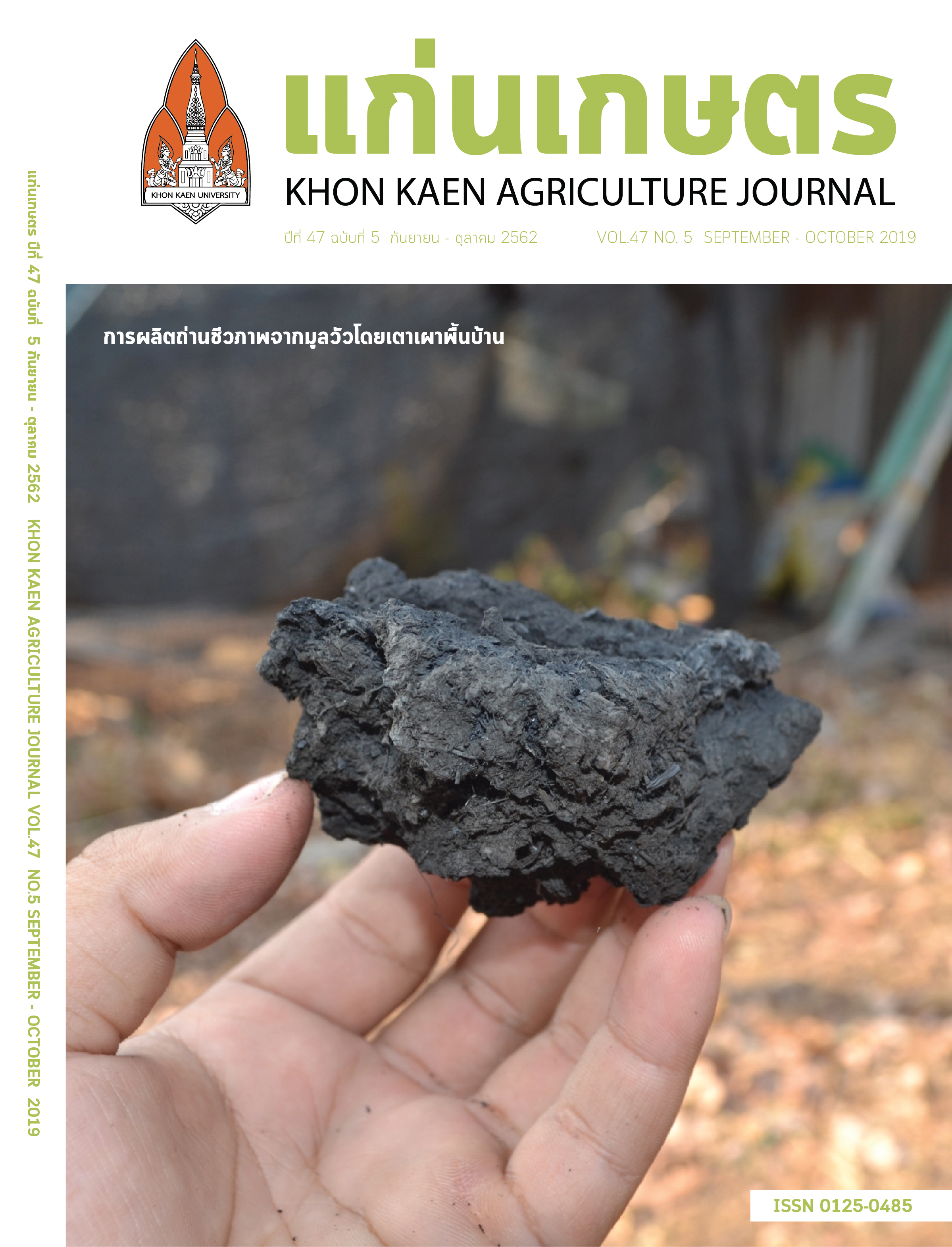ความหลากหลายทางพันธุกรรมของข้าวพันธุ์พื้นเมืองที่สูง จากกลุ่มชาติพันธุ์ในภาคเหนือของประเทศไทย
Main Article Content
บทคัดย่อ
สภาพภูมิอากาศบนพื้นที่สูงไม่เอื้ออำนวยต่อการเจริญเติบโตของข้าวพันธุ์สมัยใหม่ ดังนั้นข้าวพื้นเมืองจึงมีสำคัญต่อการดำรงชีวิตของเกษตรกรที่อาศัยอยู่บนพื้นที่สูง งานวิจัยนี้จึงมีวัตถุประสงค์เพื่อประเมินความหลากหลายทางลักษณะสัณฐานและความหลากหลายทางพันธุกรรมด้วยเครื่องหมาย microsatellites ในข้าวพื้นเมืองที่สูง 7 ชื่อพันธุ์ จำนวนทั้งหมด 28 ประชากร จาก 4 กลุ่มชาติพันธุ์ที่อาศัยอยู่ในระดับความสูงทั้งน้อยกว่าและมากกว่า 1,000 เมตรเหนือระดับน้ำทะเล และใช้เครื่องหมายจาก organelle จำแนกชนิดข้าวระหว่าง Indica และ Japonica จากการประเมินลักษณะสัณฐานพบความหลากหลายทั้งภายในประชากรและระหว่างประชากรภายในพันธุ์ เครื่องหมายจาก organelle จำนวน 3 ตำแหน่งบ่งบอกว่าข้าวพื้นเมืองที่สูง 84% เป็นชนิด Tropical japonica มีเพียง 16% ที่เป็นชนิด Indica ข้าวพื้นเมืองที่สูงในการศึกษานี้มีความหลากหลายทางพันธุกรรมสูงและมีโครงสร้างสัมพันธ์กับชนิดย่อยและระดับความสูง การศึกษาครั้งนี้แสดงให้เห็นถึงความหลากหลายทั้งลักษณะทางสัณฐานและทางพันธุกรรม รวมไปถึงโครงสร้างของประชากรข้าวพันธุ์พื้นเมืองที่สูงจากกลุ่มชาติพันธุ์ในภาคเหนือของประเทศไทย ซึ่งเป็นผลมาจากการปรับตัวเข้ากับสภาพแวดล้อมท้องถิ่น และการทำเกษตรแบบดั้งเดิม ความเข้าใจเกี่ยวกับความหลากหลายทางพันธุกรรมและโครงสร้างประชากรสามารถใช้เป็นข้อมูลพื้นฐานในการกำหนดแนวทางในการอนุรักษ์พันธุกรรมข้าวพื้นเมืองที่สูงที่ต้องอาศัยทั้งการจัดการของเกษตรกรร่วมกับการปรับตัวให้เข้ากับสภาพแวดล้อมของข้าวพื้นเมือง เพื่อการนำมาใช้ประโยชน์ต่อไป
Article Details
เอกสารอ้างอิง
อัครพงค์ อนุพันธ์พงศ์. 2550. บ้านเรือนชาวเขากะเหรี่ยงปกาเกอะญอ : ความยั่งยืนและการปรับตัว ภายใต้นิเวศวัฒนธรรมไร่หมุนเวียน. คณะสถาปัตยกรรมศาสตร์, มหาวิทยาลัยศิลปากร.
Bardenas, E. A., and T. T. Chang, 1965. Morphology and Varietal Characteristics of the Rice Plant, The. Int. Rice Res. Inst.
Bellon, M. R., J. L. Pham, and M. T. Jackson. 1997. Genetic conservation: A role for rice farmers. In N. Maxted, B.V. Ford-Lloyd and J.G. Hawkes (eds.), Plant Conservation: TheIn Situ Approach. London: Chapman and Hall.
Boonsit, P., P. Pongpiachan, S. Julsrigival, and D. Karladee. 2010. Gamma oryzanol content in glutinous purple rice landrace varieties. CMUJ. Nat. Sci. 9, 151-157.
Choudhury, B., M. L. Khan. and S. Dayanandan. 2013. Genetic structure and diversity of indigenous rice (Oryza sativa) varieties in the Eastern Himalayan region of Northeast India. SpringerPlus, 2, 228.
Cruz, N. D., and G. S. Khush, 2000. Rice grain quality evaluation procedures. Aromatic rices, 3, 15-28.Daiponmak, W., P. Theerakulpisut, P. Thanonkao, A. Vanavichit, and P. Prathepha. 2010. Changes of anthocyanin cyanidin-3-glucoside content and antioxidant activity in Thai rice varieties under salinity stress. Sci. Asia. 36:286–291.
Doyle, J.J., and J.L. Doyle. 1987. A rapid DNA isolation Procedure for small quantities of fresh leaf tissue. Focus 12: 13-15.
Earl, D. A. 2012. STRUCTURE HARVESTER: a website and program for visualizing STRUCTURE output and implementing the Evanno method. Conserv Genet Resour. . 4, 359-361.
Frankel, O.H., A.D.H. Brownand. and J.J. Burdon. 1995. The Conversation of Plant Biodiversity, Cambridge: Cambridge University Press, 299.
Goudet, J. 2001. FSTAT, a program to estimate and test gene diversity and fixation indices (version 2.9. 3). http://www2. unil. ch/popgen/softwares/fstat. htm.
Huang, X., N. Kurata. Z. X. Wang. A. Wang. Q. Zhao. Y. Zhao. and Y. Lu. 2012. A map of rice genome variation reveals the origin of cultivated rice. Nature, 490(7421), 497.
IRRI. 2013. Standard Evaluation System for Rice (SES). International Rice Research Institute, Manila, Philippines
Jamjod, S., N.Yimyam, S. Lordkaew, C. Prom-u-thai, and B. Rerkasem. 2017. Characterization of On-farm Rice Germplasm in an Area of the Crop’s Center of Diversity. CMUJ. Nat. Sci. 16, 85-98.
Juliano, B.O. 2007. Rice chemistry and quality. Philippines: Philrice. p. 402.Liu, K., and S. V. Muse. 2005. PowerMarker: an integrated analysis environment for genetic marker analysis. Bioinformatics, 21, 2128-2129.
Lu, B.R., X. Cai. and J. Xin. 2009. Efficient indica and japonica rice identification based on the InDel molecular method: its implication in rice breeding and evolutionary research. Progress in Natural Science, 19(10), pp.1241-1252.
Maclean, J., B. Hardy, and G. Hettel. 2013. Rice Almanac : Source Book for One of the Most Important Economic Activities on Earth. IRRI. Los Baños, Philippines.
Mulumba, J.W., R. Nankya, J.Adokorach, C. Kiwuka, C. Fadda, P. De Santis, and, D.I. Jarvis. 2012. A risk-minimizing argument for traditional crop varietal diversity use to reduce pest and disease damage in agricultural ecosystems of Uganda. Agriculture, Ecosystems and Environment 157: 70-86.
Okoshi, M., K. Matsuno, K. Okuno, M. Ogawa, T. Itani, and T. Fujimura. 2015. Genetic diversity in Japanese aromatic rice (Oryza sativa L.) as revealed by nuclear and organelle DNA markers. Genet. Resour. Crop Evol. 63: 199-208.
Peakall, R. O. D., and P. E. Smouse. 2006. GENALEX 6: genetic analysis in Excel. Population genetic software for teaching and research. Molecular Ecology Resources, 6, 288-295.
Pintasen, S., S. Jamjod, N. Yimyam, and B. Rerkasem, 2007. Variation of grain iron content in a local upland rice germplasm from the village of Huai Tee Cha in northern Thailand. Euphytica, 158(1-2), 27-34.
Prathepha, P., and K. Srisa-ard. 2014. Application of InDel markers for subspecies indica-japonica rice classification in Thai rice germplasm. Genomics and Genetics, 7, 87-96.
Pritchard, J.K., M. Stephens, and P. Donnelly 2000. Inference of population structure using multilocus genotype data. Genetics. 155: 945-959.
Pusadee, T., S. Jamjod, Y.C. Chiang, B. Rerkasem, and B.A. Schaal. 2009. Genetic structure and isolation by distance in a landrace of Thai rice. Proc. Natl. Acad. Sci. U.S.A. 106: 13880-13885.
Pusadee, T., P. Oupkaew, B. Rerkasem, S. Jamjod, and B.A. Schaal. 2014. Natural and human-mediated Selection in a landrace of Thai rice (Oryza sativa). Annals of Applied Biology. 165: 280-292.
Schiller, J. M. 2006. Rice in Laos. Int. Rice Res. Inst..
Shannon, C.E., and W. Weaver. 1949. The Mathematical Theory of Communication. [SI]. Urbana.
Shrestha, R. P., N. Chaweewan. and S. Arunyawat. 2017. Adaptation to Climate Change by Rural Ethnic Communities of Northern Thailand. Climate, 5, 57.
Wang, Y., Y. Wang, X. Sun, Z. Caiji, J. Yang, D. Cui, and L. Han. 2016. Influence of ethnic traditional cultures on genetic diversity of rice landraces under on-farm conservation in southwest China. J Ethnobiol Ethnomed. 12: 51.
Xiong, Z., S. Zhang. Y. Wang. B.V. Ford-Lloyd. M. Tu. X. Jin. Y. Wu. H. Yan. X. Yang. P. Liu. B.R. Lu. 2010. Differentiation and distribution of indica and japonica rice varieties along the altitude gradients in Yunnan province of China as revealed by InDel molecular markers. Genet. Resour. Crop Evol. 57: 891–902.


